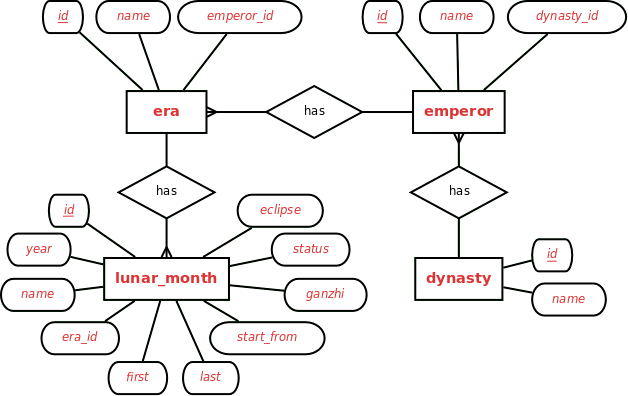

The Entity Relation Diagram (ERD) for the DDBC Time authority Database is as follows:

The database contains four entities: dynasty, emperor, era and lunar_month.
A dynasty entity represents a dynasty (朝代) in Chinese history. Each dynasty has a name and a unique key, id. A dynasty will usually encompass the reigns of several different emperors (皇帝). Each emperor entity has three attributes: name and id, and a dynasty_id which refers the parent dynasty. Each emperor's reign consists of one or more eras (年號), represented as era entities in the database. An era entity also has name and id attributes, and the emperor_id of its parent entity. Finally, each era consists of one or more lunar_month entities (月).
In DDBC Time Authority Database, the lunar month is the smallest unit of data: i.e. the database does not store a record for each day. Nevertheless, the details of an individual day can be derived from the corresponding lunar_month entity. A lunar_month entity consists of nine attributes: id is the unique identifier; year is an ordinal number indicating the year of the era; name is the name of the month in Chinese; and era_id is the unique id of the parent era; first and last are Julian Day numbers specifying the first day and the last day of the month, and start_from indicates the ordinal day of the month from which this record is valid (usually day 1). The ganzhi (干支) field stores the sexagenary designation of the solar year to which the lunar month belongs. Status is currently one of two values: 'S' for standard; or 'P' for proleptic. Finally, eclipse records whether the first day of this month corresponds to a solar eclipse.
For more details, see the Table Schemas, and make sure to read the important notes.
 |
The DDBC Time Authority Database from Dharma Drum Buddhist College (法鼓佛教學院) is licensed under a Creative Commons Attribution-Share Alike 2.5 Taiwan License. |